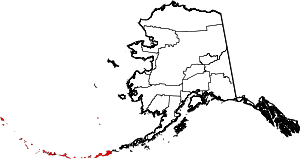Nikolski, Alaska
| Nikolski | |
|---|---|
| CDP | |
|
Aerial Photo of Nikolski | |
 Nikolski | |
| Coordinates: 52°56′29″N 168°51′39″W / 52.94139°N 168.86083°WCoordinates: 52°56′29″N 168°51′39″W / 52.94139°N 168.86083°W | |
| Country | United States |
| State | Alaska |
| Census Area | Aleutians West |
| Government | |
| • State senator | Lyman Hoffman (D) |
| • State rep. | Bryce Edgmon (D) |
| Area | |
| • Total | 132.8 sq mi (344.0 km2) |
| • Land | 132.1 sq mi (342.1 km2) |
| • Water | 0.7 sq mi (1.9 km2) |
| Population (2010) | |
| • Total | 18 |
| • Density | 0.3/sq mi (0.1/km2) |
| Time zone | Alaska Standard (AKST) (UTC-9) |
| • Summer (DST) | Alaska Daylight (AKDT) (UTC-8) |
| ZIP code | 99638 |
| Area code(s) | 907 |
| FIPS code | 02-54260 |
Nikolski (Chalukax̂[1] in Aleut) is a census-designated place (CDP) on Umnak Island in Aleutians West Census Area, Alaska, United States. The population was 18 at the 2010 census.
Geography

Nikolski is located at 52°56′29″N 168°51′39″W / 52.941485°N 168.860765°W.[2]
According to the U.S. Census Bureau, the CDP has a total area of 132.8 square miles (344 km2), of which, 132.1 square miles (342 km2) of it is land and 0.7 square miles (1.8 km2) of it (0.55%) is water.
On a clear day the view from Nikolski is dominated by Mount Vsevidof to the northeast, the highest point on Umnak Island.
The boundary between the Alaska Time Zone (UTC-9) and Hawaii-Aleutian Time Zone (UTC-10) passes just west of Nikolski, along the line of 169°30'W[3] through Samalga Pass.[4] This places Nikolski in the Alaska Time Zone. However, as Nikolski is part of the Aleutian Region School District the settlement effectively observes Hawaii-Aleutian time.[5]
Demographics
As of the census[6] of 2000, there were 39 people, 15 households, and 12 families residing in the CDP. The population density was 0.3 people per square mile (0.1/km²). There were 28 housing units at an average density of 0.2/sq mi (0.1/km²). The racial makeup of the CDP was 30.77% White and 69.23% Native American.
There were 15 households out of which 40.0% had children under the age of 18 living with them, 53.3% were married couples living together, 20.0% had a female householder with no husband present, and 20.0% were non-families. 20.0% of all households were made up of individuals and none had someone living alone who was 65 years of age or older. The average household size was 2.60 and the average family size was 2.92.
In the CDP the population was spread out with 35.9% under the age of 18, 30.8% from 25 to 44, 23.1% from 45 to 64, and 10.3% who were 65 years of age or older. The median age was 40 years. For every 100 females there were 105.3 males. For every 100 females age 18 and over, there were 92.3 males.
The median income for a household in the CDP was $38,750, and the median income for a family was $40,250. Males had a median income of $26,250 versus $11,875 for females. The per capita income for the CDP was $14,083. There were 23.5% of families and 20.7% of the population living below the poverty line, including 13.6% of under eighteens and 55.6% of those over 64.
Education

Nikolski is served by the Aleutian Region Schools.
The Nikolski School serves grades K-12. The school has one live-in teacher that occupies a small home owned by the school district adjacent to the school building purpose-built for teachers and their family.
The Nikolski School is in danger of extinction. Schools in rural Alaska must have at least 10 students to retain funding from the state. For the 2009-2010 school year, however, the Nikolski School has only nine students.[7][8] This school is now closed per the district website.
References
- ↑ Bergsland, K. (1994). Aleut Dictionary. Fairbanks: Alaska Native Language Center.
- ↑ "US Gazetteer files: 2010, 2000, and 1990". United States Census Bureau. 2011-02-12. Retrieved 2011-04-23.
- ↑ Code of Federal Regulations, 49 CFR 71.12
- ↑ Federal Aviation Administration, Dutch Harbor Sectional Aeronautical Chart, Retrieved from SkyVector.com on April 12, 2008
- ↑ e-mail communication with Dan Masoni, Librarian, Unalaska Public Library, 2008-06-18; see also http://osdir.com/ml/time.tz/2004-11/msg00009.html
- ↑ "American FactFinder". United States Census Bureau. Archived from the original on September 11, 2013. Retrieved 2008-01-31.
- ↑ Yardley, William (November 25, 2009). "Alaska's Rural Schools Fight Off Extinction". New York Times. Retrieved May 20, 2010.
- ↑ Olsen, Erik (November 25, 2009). "An Alaskan Village in Crisis". New York Times.
External links
- Historic American Buildings Survey (HABS) No. AK-95, "Village of Nikolski, Nikolski, Aleutians West Census Area, AK"

